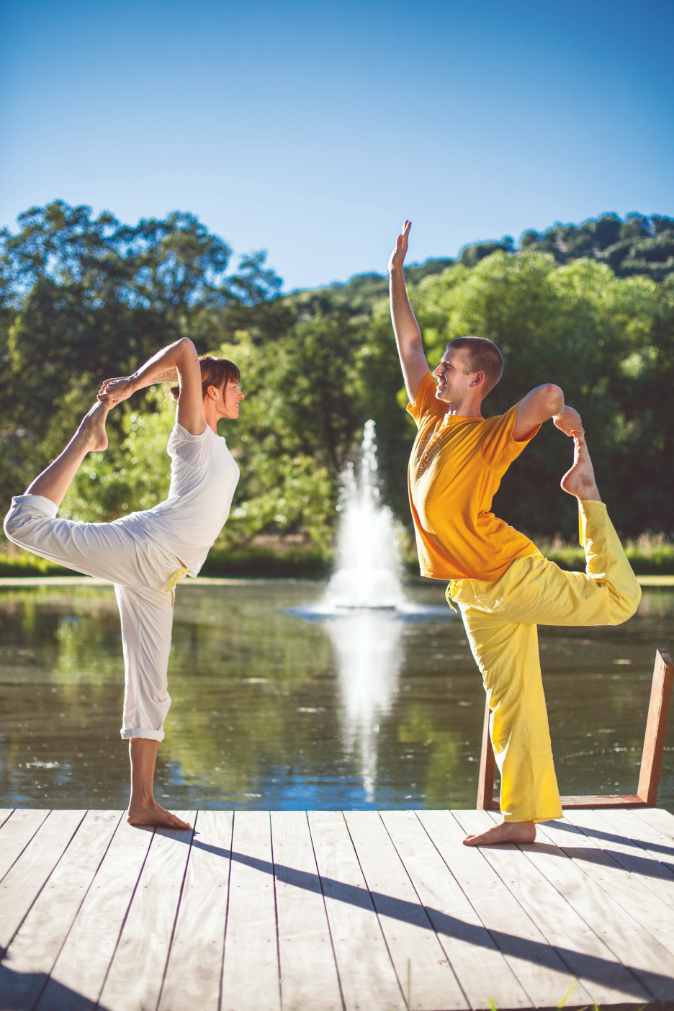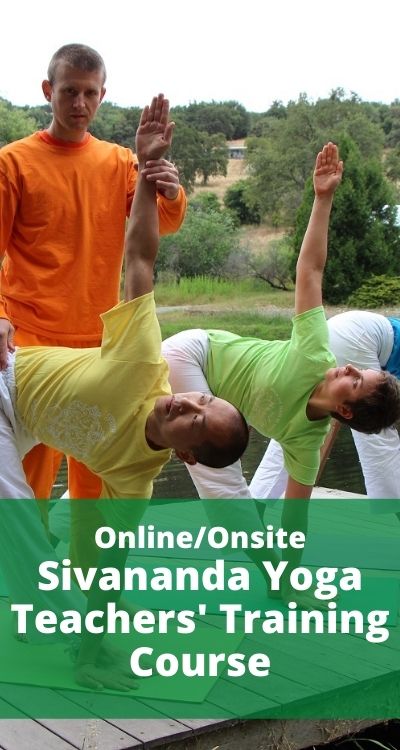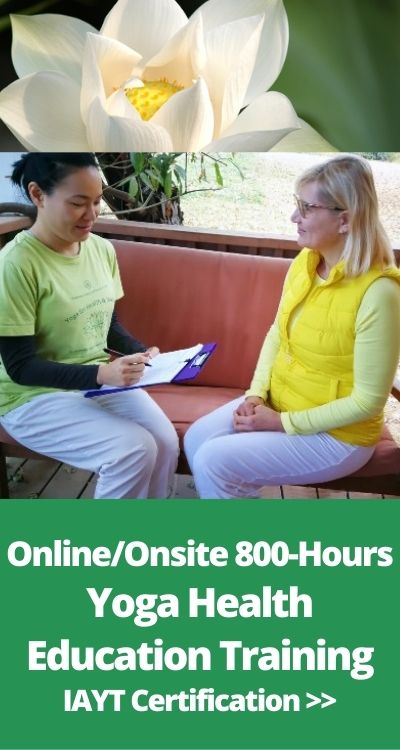
Your subtle body translated as Sanskrit mantra, Sanskrit vowels, Sanskrit sound. When you hear the sound you would calm down. It is not like a normal song that you feel good about. This is like a sound therapy. When you say OM that is a Sanskrit sound. All languages are condensed in OM. OM is in all the chants.
Sanskrit mantras are not in our culture but you are learning yoga and you are learning it in the ashram so you go to the root of the source of yoga the same way it was taught in ancient time.
You will be exposed to things that you are not used to. Like the Sanskrit mantras but if you are open to it and you listen it caches your attention and at the end of the week you will learn some mantras.
Here we use OM NAMAH SIVAYA as a salutation. Namah means salutation, prostration. If you put your palms together in front of your heart you already feel better. You feel centered. Our life is mostly split. I am here but I want to be there. I am doing this I want to do that. I love this person I love this person too. Yoga will teach you slowly things that you do that would bring the experience of being together, be one. So your hands are separated (split) and when you put the two hands together you the whole body is put together and you bow. Means you learn how to unite together and you learn how to pay respect to life, to that who creates life. That is the spirit of yoga. Sivaya is the name of the God that is the creator of all the yoga posture. He is the creator of all the yogis. A yogi is a person who practices yoga and a yogini is the female person that practices yoga. But usually that term is applied to a person who has mastered yoga science.
OM NAMAH SIVAYA is a mantra. We use this mantra so we don’t relate to each other with our external appearance. We refer to each other as the inner spiritual being that is one.
What do we learn in yoga?
We find out about our self, our inner spirit, and how to connect to the inner spirit of others. The advantage of doing that is to have peace because you don’t compare anymore instead you see them as yourself as one. Yoga means union between you and others. Between you and the universe. Union means to harmonize the different portions of you self, body, mind and spirit.
What is more important, body, mind or spirit?
Everything is important but it is said that spirit is more important because spirit is the driver of the vehicles. The body and the mind are the vehicles and the spirit is the driver of the vehicles. That means you own your life, your body, your mind. You better be the driver. Sometimes we don’t do that. Something else is more important and we do things that makes us lose control.
The five points of yoga life.
Yoga life is a life that will lead you to self control, to health, to peace of mind.
1. Learn how to introduce the proper way how to do exercise in your life.
2. Learn how to integrate the proper breathing exercise in your daily life.
3. Learn how to introduce relaxation in your daily life.
4. Learn how to nourish yourself properly. The food that will nourish your body, mind and spirit.
5. Learn how to work on your mind to control your mind. Positive thinking and how to meditate.
These are the five aspects of yoga life. That is what you will learn this week.
Proper exercise – Asanas
What does asana mean?
Asana means steady posture. Normally we are all the time in postures. Through out the day you put your body in different kinds of postures but the asana is the perfect posture that will give you many benefits. It is like learning ABC, the alphabet. When you learn the posture you go back to the basic posture it’s like building up the ABC, and once you know the ABC you can build up sentences. So you need to learn the basic postures and the benefits of it and then you learn the variations and you add to it.
In the Sivananda yoga system there are 12 basic (fundamental) postures.
We start always with Sun Salutation (Suryanamaskar). In sun salutation there are 12 positions. Suryamanaskar is considered an exercise. It helps you to active your vascular system and warms up all your muscles so you can hold the postures. This is the only one that can be done fast. We do not advise it that you do it fast but you can do it if you want to.
In yoga we call the postures asanas because exercise refers to only the body. Physical exercise is about building muscles in the body. The yoga asanas work in a deeper level of your self. Sometimes we use the word exercise for people to relate to but the right word is yoga asana.
These 12 fundamental postures or asanas need to be practiced in the right sequence. The correct way is to have a relaxation at the beginning and the relaxation at the end and you have relaxation in between postures, because relaxation and breathing are part of the practice. To practice a posture, you breathe, and you relax. You have to be focused, aware.
Physical benefits of the asanas
Work out all the different systems of the body.
1. Muscular system making the muscles strong and flexible as opposed to the exercises that only make the muscles strong.
2. Skeletal system making the body aligned.
3. Breathing system, cleaning out your lungs.
4. Cardio vascular system.
5. Digestive system.
6. Endocrine system affecting all your glands.
7. Nervous system
After the sun salutation the next posture is inverted posture. Next is the forward bend. Next is backward bend. Next is twist. Next balancing. These are the different grouping of the postures.
The 12 postures are:
1. Head stand
2. Shoulder stand
3. The plow
4. The fish
5. Forward bend
6. Cobra
7. Locus
8. Bow
10. Crow
11. Standing forward bend
12. Triangle
Why do you start with inverted postures first?
You start the postures on your head and you end on your feet because it helps to change the perspective. Basically the inverted postures bring a flow of blood to your brain and mentally you change your perspective. You see things different and you have to balance your self in the posture.
Mental benefits of yoga asanas
The mind balances and centers. You become more focused because you have to concentrate. You focus on your breathing. You become calmer and more open emotionally. You increase your energy.
Spiritual benefits of yoga asanas
You become more aware. You feel more connected to your purpose to be alive in this body. Develop more faith.
How are the movements of the asanas done?
They are done slowly. There are not jerky movements like in the exercise movements. You do them slowly with awareness. If you do the asanas quick your astral body gets shaken up. You don’t want that to happen. In yoga you want to be calm and not to shake up anything. It takes time after you master a posture. When you do and asana you breathe into it and you relax and slowly you master it. It is very important not to have competition. In physical exercises there is competition but not in yoga. When you practice asanas you do it for your self. You can have the eyes close or you can have them open but do not look at the others so that you won’t compare your self to the others. It is an introverted exercise. Physical exercise is extroverted. It is about your own journey. It is about pulling your mind inward.
What is the benefit of pulling your mind inward?
It is to withdraw the senses pulling the senses inward. When the senses are outward and you are distracted you lose all energy. So when doing asanas you pull your energy inward, you breathe and you circulate your energy. There are mental and energetic benefits. Energetic benefits it means you get more energy, you balance your energy. When you do the sequence of postures and the breathing and relaxation you are moving the energy. Each posture activates a different energy center and the energy gets activated.
Relaxation in yoga posture
In the physical exercise the muscles are being build and also the mental stress, which causes fatigue. In yoga you make an effort and then you relax so you can go for a long time without fatigue. When you look at somebody doing an advance yoga posture it looks easy but they are making a big effort. They look relaxed. When you look at the person doing a physical exercise they are puffing and look like they are making a bigger effort.
The yoga postures work in many different levels so not fatigue is produced when you practice. You need a lot of your mental power to learn to direct you body and inhale to get more energy, exhale all the fatigue out. Focus when you feel pain in your body and relax.
How do asanas affect the spinal column?
In the yoga asanas you are working in the flexibility of your spinal column. It is very important because is holding your posture and when you start to meditate the energy circulates in your spinal column. That is why it is so important your spine is flexible so you don’t have blockages in your spine and injury to your spine. It is said that a flexible spine is a flexible mind.
How long and how to practice?
There are 84,000 yoga postures. Swami Vishnudevananda put together the 12 postures because if you practice them with the breathing and the relaxation in between and the relaxation in the end and the sun salutation and the effort of focusing, it should take you one hour. If you do it deeper then it would take you one hour and a half. If you do it with variations it could take 2 to 3 hours. It is good to practice one hour to one hour and a half every day.
The key thing in yoga is balance. When you do something to the right you do also the left side. When you bend forward you need to bend backward, all the time keeping the balance. That helps the energy to flow.
Keep in mind the not competition. You start where you are even if you cannot do the posture because you are stiff. Whenever you feel pain you stop. You focus where the pain is and focus on your breath and relax. You do not force the posture. Always effort and relaxation. Relaxation alone is not enough you need to put the effort. Effort alone without relaxation is not good. In a group you have certain kind of rhythm. It is good to follow everything that the teacher says to follow the rhythm of the group and you can benefit from the energy of the group as well. If you do whatever you want you create your own energy and sometimes you will go counter current of the energy and that does not help you. If you follow the group energy it will be easier for you.
There are three faces to a posture. There is a coming in, a holding and the coming out. Coming in is done step by step and then you hold the posture breathing very calm and in the coming out your breathing is deep. When holding the posture you calm down your breath and you focus to get the benefits of the posture. The posture must be comfortable. In the beginning it is a little bit uncomfortable but then you breathe and relax and you become comfortable that is why you hold the posture. When you hold the posture in a comfortable manner without any stress then at that time you get all the benefits. When you hold the posture you are building up the pressure in your nadis (energy channels) then you release the posture so the energy flows and unblocks your energy channels. That is the main benefit of the asanas. After releasing the posture you always come back to savasana posture, the relaxation posture. We will talk about the benefits of relaxation later.
In this course we will not teach any of the variations. Later you can come back and take the intermediate course to learn some variations. You still keep the sequence but you add some more postures.
Eat two hours before the asana session. The best time to practice is early morning after meditation in a cool ventilated quiet place with a level floor. In this system we don’t practice with music or any props. We don’t need it because the body is the perfect instrument. Only the people that may have some physical problem use props. You can also practice asanas anywhere.
Clothes to use during asana practice
You would need to get your own asana mat and your own yoga pillow and your own yoga clothing. The clothes best to be cotton because it breathes better and they should be loose. Do not use belts. Do not practice wearing jeans. The room where you practice yoga needs to be clean, sunny. Practice outdoor is best. Hold the posture one to three minutes. At the beginning hold it only like 30 seconds. To get the full benefits of the posture ideally you hold the posture for three minutes. Get rid of whatever might distract you. Do not hurry when practicing. Make sure to make the time to practice. Do not skip the postures.
After you finish the practice wait at least 30 minutes before you take a shower because when you finish your postures the astral body energy is very good and you want to enjoy that time. You need to practice minimum five times a week. The female can skip the inverted postures during the menstruation period.
Asanas with spinal injuries
If you have spinal injury or surgery to your spine, or neck injury, or any other injury you need to talk to your teacher and you need to be careful. Considering the yoga posture and the breathing and the circulation of prana you can do it modifying the posture. Even lying down in the savasana posture and you move the body right and left because you have pain, you already get the benefits.
How to start the practice
We usually start the practice with a prayer (Gajananam) invoking the energy of the teachers, the masters, please remove all the distractions of my mind so I can be here, that I can get the benefit and I can get the knowledge. Basically that is the meaning of the prayer. We say the peace prayer at the end (Tryambakam). It is a peace prayer and a healing prayer.
OM OM OM
© Swami Sitaramananda 2014 No part of this article may be reproduced in any form without the written permission of the author.


